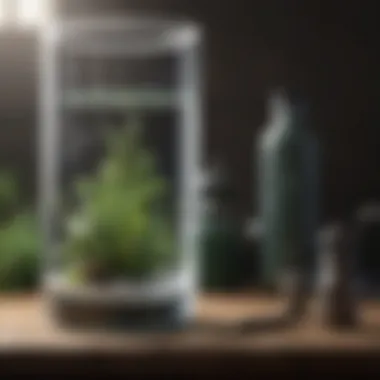Step-by-Step Guide to Constructing a Water Filtration System for Clean and Sustainable Water


Nature Topic Overview
Water filtration systems are essential for ensuring access to clean and safe water, a fundamental resource for our well-being and the environment's sustainability. This comprehensive guide dives deep into the process of building a water filtration system from scratch, highlighting the key materials and steps required to create an efficient filtration system tailored to various needs.
DIY Filtration System Essentials
To embark on the journey of creating your DIY water filtration system, you will need to gather essential materials such as a large bucket, sand, gravel, activated charcoal, a water source, a spigot, and a drill. These items are vital for the filtration system's functionality as they collectively work to remove impurities and contaminants from the water, ensuring that the end result is clean and safe for consumption.
Step 1: Preparing the Container
Begin by selecting a large bucket or container that is clean and free from any residues. This vessel will serve as the base for your filtration system, holding the filtering materials in place and collecting the purified water. With the drill, create a hole near the bottom of the container to install the spigot, allowing easy access to the filtered water.
Step 2: Layering the Filtration Materials
Once the container is prepared, it is time to layer the filtration materials in the designated order. Start by adding a layer of clean gravel at the bottom, followed by a layer of sand and activated charcoal. These layers act as barriers to trap impurities and improve the water's quality as it passes through each material.
Step 3: Testing and Adjusting
After assembling the filtration system, pour water into the container and observe the filtration process. Monitor the flow of water and clarity to ensure that the system is effectively removing contaminants. Make any necessary adjustments to the layers or materials to enhance the filtration efficiency.
Step 4: Enjoying Clean Water
Once the water has passed through the filtration system and the desired level of purification is achieved, turn the spigot to collect the clean water. Revel in the satisfaction of creating your DIY water filtration system and the assurance of having access to safe and clean water for various purposes.
Environmental Impact and Sustainability
Building a water filtration system not only promotes personal health and well-being but also contributes to environmental conservation by reducing the need for single-use plastics and bottled water. By embracing sustainable practices in water filtration, individuals can play a significant role in preserving natural resources and minimizing environmental degradation.
Conclusion
Introduction
In the realm of sustainable living, understanding how to build a water filtration system is paramount. Clean water is not just a commodity; it's a necessity for a healthy life. This comprehensive guide delves into the intricacies of constructing a water filtration system from scratch. With a focus on clean water and sustainability, readers will glean insights into the importance of ensuring access to safe drinking water. Whether for personal use or educational purposes, learning the art of building a water filtration system can empower individuals to make a tangible difference in promoting environmental welfare.
Understanding the Importance of Clean Water
Impact on Health
When exploring the impact of clean water on health, one cannot underestimate its significance. Access to clean water is directly correlated with improved health outcomes, reducing the risk of waterborne diseases and fostering well-being. The purity of water plays a pivotal role in maintaining a healthy body, making it a crucial element in any filtration system. By prioritizing the quality of water we consume, we embark on a journey towards a healthier lifestyle.
Environmental Significance
The environmental significance of clean water extends beyond personal health to ecological balance. Clean water ecosystems support a myriad of aquatic life forms and contribute to overall biodiversity. By acknowledging the environmental impact of water pollution, we underscore the importance of preserving natural habitats and promoting sustainability. Understanding the ripple effect of clean water on ecosystems underscores the critical role it plays in maintaining a harmonious environment.


Benefits of a DIY Water Filtration System
Cost-Effectiveness
One of the key advantages of a DIY water filtration system is its cost-effectiveness. By opting to build a filtration system from scratch, individuals can minimize expenses associated with purchasing pre-built systems. Cost-effective solutions offer a sustainable approach to water filtration, aligning with the principles of efficiency and affordability. Whether on a budget or seeking long-term savings, the DIY approach presents a compelling case for those looking to secure clean water without hefty financial investments.
Customization Options
The beauty of a DIY water filtration system lies in the realm of customization options it presents. Tailoring the filtration system to individual preferences and water quality needs allows for a personalized touch. From selecting specific filters to customizing the flow rate, DIY enthusiasts can fine-tune their filtration system to perfection. This level of customization empowers users to address specific water concerns effectively, creating a bespoke solution that meets unique requirements.
Materials Needed
In this guide on building a water filtration system, the section on Materials Needed plays a crucial role in emphasizing the essential components required for constructing an efficient system. When delving into the Materials Needed, it is imperative to consider the primary components such as Filters, Containers, and Tubing along with Additional Tools like Scissors, Wrench, and Measuring Tape. These elements are the building blocks of the filtration system and ensuring their quality and compatibility is key to the system's functionality and performance.
Primary Components
Filters
Filters are a fundamental element of any water filtration system, playing a pivotal role in the purification process. They are designed to remove impurities, sediments, and contaminants from the water, ensuring a clean and safe output. The key characteristic of Filters lies in their diverse filtration capabilities, ranging from sediment filtration to activated carbon filtration. Filters offer a reliable and effective solution for achieving high water quality and are a popular choice due to their efficiency and affordability. Despite their undeniable benefits, Filters require regular maintenance and replacement to sustain optimal performance.
Containers
Containers are essential for holding the filtered water and facilitating the flow through the filtration system. The key characteristic of Containers is their durability and capacity to withstand varying water volumes. Choosing the right Container size is crucial to meet the water demand and ensure uninterrupted filtration. Containers are a beneficial choice for their reliability and compatibility with different filtration setups. However, their size and material composition may impact portability and maintenance requirements.
Tubing
Tubing serves as the pathways through which water flows within the filtration system, connecting different components seamlessly. The key characteristic of Tubing lies in its flexibility and resistance to impact and pressure. Tubing provides a reliable and leakage-free solution for directing water, ensuring efficient filtration. Its unique feature includes easy customization to fit specific system designs and requirements. While Tubing offers convenience and versatility, proper sizing and installation are essential to prevent kinks and blockages in the water flow.
Additional Tools
Scissors
Scissors are indispensable for cutting Tubing, Filters, and other materials during the assembly process. The key characteristic of Scissors is their sharp blades and ergonomic design, enabling precision cuts without fraying or damaging the components. Scissors are a popular choice for their versatility and ease of use in creating customized filtration setups. However, improper handling or maintenance of Scissors may lead to reduced cutting efficiency and potential safety hazards.
Wrench
A Wrench is essential for securely fastening components like Filters and Containers to prevent leaks and ensure system integrity. The key characteristic of a Wrench lies in its adjustable jaws and sturdy construction, offering a tight grip on different types of connectors and fittings. Wrenches are a beneficial choice for their strength and torque application, facilitating effortless installation and maintenance tasks. Despite their advantages, selecting the right Wrench size and type is crucial to avoid damaging delicate components.
Measuring Tape
A Measuring Tape is crucial for accurate sizing and dimensioning of Components and Tubing during the assembly process. The key characteristic of a Measuring Tape is its extendable length and reliable markings, enabling precise measurements for precise cuts and fittings. Measuring Tapes are a popular choice for their portability and ease of use, ensuring proper alignment and configuration of components within the filtration system. However, attention to calibration and storage is necessary to maintain measurement accuracy and consistency.
Types of Filtration Methods


In this article, understanding the varied Types of Filtration Methods is crucial for creating an effective water filtration system. Mechanical Filtration, Biological Filtration, and Chemical Filtration are the key categories to explore. Each method offers distinct benefits and considerations that impact the overall efficiency and quality of the filtration process. Mechanical Filtration focuses on physically removing impurities like sediment and particles, ensuring clearer water. Biological Filtration utilizes beneficial bacteria and aquatic plants to break down organic matter, enhancing water purity. Chemical Filtration involves removing impurities such as chlorine and fluoride through specific treatment processes, ensuring safe and clean drinking water.
Mechanical Filtration
Sediment Filtration
Sediment Filtration plays a critical role in eliminating solid particles and debris from water sources, preventing clogging and improving water clarity. The key characteristic of Sediment Filtration lies in its ability to trap and remove large particles effectively, enhancing the overall quality of filtered water. This method is a popular choice due to its simplicity and efficiency, offering a cost-effective solution for particulate removal. However, one potential disadvantage of Sediment Filtration is the possibility of sediment buildup, necessitating regular maintenance to optimize filtration performance.
Activated Carbon
Activated Carbon is a highly effective filtration medium known for its adsorption properties, which attract and trap impurities like chemicals and odors. The key characteristic of Activated Carbon is its ability to enhance water aesthetics and taste by eliminating unwanted components. This approach is favored for its versatility and extensive application in purifying water. One unique feature of Activated Carbon is its capacity to reduce contaminants while retaining essential minerals, contributing to healthier drinking water. Despite its advantages, Activated Carbon may require periodic replacement to uphold filtration efficacy.
Biological Filtration
Beneficial Bacteria
Beneficial Bacteria contribute significantly to water filtration systems by breaking down organic matter and reducing harmful substances. The key characteristic of Beneficial Bacteria is their ability to establish a balanced microbial environment, promoting water quality and clarity. This method is a popular choice for its eco-friendly nature and sustainable approach to filtration. A unique feature of Beneficial Bacteria is their role in maintaining biological equilibrium, essential for natural water purification. While offering numerous benefits, it is essential to monitor and maintain optimal conditions for Beneficial Bacteria to thrive.
Aquatic Plants
Aquatic Plants play a vital role in biological filtration by absorbing nutrients and impurities, contributing to water oxygenation and clarity. The key characteristic of Aquatic Plants is their capacity to create a natural and aesthetically pleasing filtration environment. This method is favored for its enhancement of aquatic ecosystems and provision of natural filtration solutions. A unique feature of Aquatic Plants is their ability to adapt to varying water conditions while promoting biodiversity. However, regular maintenance and monitoring are necessary to prevent overgrowth and ensure continued filtration benefits.
Chemical Filtration
Chlorine Removal
Chlorine Removal is essential in water filtration to eliminate this disinfectant, which can affect water taste and quality. The key characteristic of Chlorine Removal is its efficacy in neutralizing chlorine compounds, enhancing water safety for consumption. This method is a beneficial choice for improving water palatability and odor. One unique feature of Chlorine Removal is its fast-acting properties, providing immediate results in water treatment processes. However, excessive exposure to chlorine removal chemicals may lead to adverse environmental impacts, requiring cautious usage.
Fluoride Reduction
Fluoride Reduction focuses on decreasing excess fluoride levels in water, safeguarding against potential health risks associated with elevated fluoride intake. The key characteristic of Fluoride Reduction lies in its ability to regulate fluoride concentrations within recommended limits, ensuring water safety. This method is valuable for promoting dental health and addressing fluoride-related concerns. A unique feature of Fluoride Reduction is its role in preventing dental fluorosis while maintaining beneficial fluoride levels for oral health. Despite its advantages, prolonged use of fluoride reduction methods should be accompanied by water quality testing to monitor fluoride levels effectively.
Assembly Process
In the world of water filtration systems, the assembly process holds a crucial position. It is the phase where individual components seamlessly come together to form a functional and efficient system. The assembly process is the backbone that ensures all the elements work cohesively to deliver clean and safe water for various purposes. From selecting the right materials to connecting components correctly, each step in the assembly process contributes significantly to the system's overall performance.
Setting Up the Filtration System
Choosing the Right Location
When it comes to setting up a water filtration system, choosing the right location plays a pivotal role in its effectiveness. The location must be strategically selected to optimize the system's performance and ensure easy access for maintenance tasks. Selecting a spot near the water source, away from potential contaminants, is essential for enhancing the system's efficiency. Additionally, positioning the system in a well-ventilated area can prevent the accumulation of harmful bacteria, promoting cleaner water output. The choice of location can determine the system's longevity and the quality of water it produces, making it a critical decision in the filtration system setup.
Connecting Components


The process of connecting components is the technical glue that binds the filtration system together. Each component must be connected with precision and care to avoid leaks or inefficiencies in water flow. Properly connecting the filters, containers, and tubing in alignment with the system design is essential for maximizing filtration effectiveness. Ensuring tight seals and secure connections can prevent water wastage and contamination, guaranteeing a steady supply of clean water. Attention to detail in connecting components is key to maintaining the system's integrity and performance over time.
Installing Filters
Proper Sequence
The proper sequence of filter installation is paramount in achieving optimal water filtration results. Each filter must be installed in the correct order to facilitate the removal of impurities effectively. Beginning with a sediment filter to remove large particles followed by an activated carbon filter for chemical filtration ensures thorough purification. Adhering to the recommended sequence prevents clogging of filters and preserves their longevity, contributing to sustained water quality. Following the proper sequence meticulously is a simple yet essential step in maximizing the filtration system's purification capabilities.
Maintenance Tips
Regular maintenance is key to the longevity and efficiency of a water filtration system. Implementing proper maintenance tips, such as routine filter replacements and cleaning procedures, is vital for sustaining water quality. Replacing filters at recommended intervals and cleaning components regularly prevent buildup of contaminants and ensure optimal performance. Proper maintenance prolongs the life of the system, reduces the risk of malfunctions, and maintains the purity of filtered water. Consistent adherence to maintenance tips is a proactive approach to preserving the functionality and reliability of the filtration system.
Testing and Maintenance
Testing and maintenance are crucial aspects of building a water filtration system. Ensuring the quality of the filtered water is essential to guarantee the system's efficiency and the safety of the water for consumption. Through regular testing and proper maintenance, any potential issues can be detected early, preventing contamination and ensuring continuous access to clean water. Water quality testing helps in identifying impurities or pollutants that may impact the water's safety. Regular maintenance, including filter replacement and cleaning procedures, is necessary to keep the system working optimally. By prioritizing testing and maintenance, users can uphold the integrity of their filtration system and safeguard the quality of the water they consume.
Water Quality Testing
Water quality testing plays a fundamental role in maintaining the efficacy of a water filtration system. Testing kits are essential tools that allow users to analyze various water parameters, such as pH levels, chlorine content, and presence of contaminants. These kits provide valuable insights into the quality of the filtered water, helping users make informed decisions about their water consumption. The unique feature of testing kits lies in their simplicity and user-friendliness, making them a popular choice for individuals constructing DIY filtration systems. However, while testing kits offer convenience, they may have limitations in providing detailed water analysis.
Interpreting Results
Interpreting the results of water quality testing is vital for understanding the implications of the obtained data. By interpreting results accurately, users can assess the effectiveness of their filtration system and identify potential areas for improvement. The key characteristic of interpreting results is the ability to translate complex data into actionable insights, guiding users on necessary adjustments to enhance water quality. While interpreting results empowers users to make informed decisions, it requires some level of expertise to derive meaningful conclusions. Despite its benefits, incorrect interpretation of results may lead to misinformed actions, potentially compromising the efficiency of the filtration system.
Regular Upkeep
Regular upkeep of a water filtration system is essential to ensure its longevity and efficiency. Filter replacement is a critical aspect of maintenance, as filters degrade over time due to continuous use. By promptly replacing filters according to the manufacturer's recommendations, users can maintain the system's effectiveness and the quality of the filtered water. The key characteristic of filter replacement lies in its preventive nature, addressing potential issues before they impact water quality significantly. However, the cost and availability of replacement filters may pose challenges for some users.
Cleaning Procedures
Cleaning procedures are integral to preserving the functionality of a water filtration system. Regular cleaning prevents the buildup of impurities, mold, and bacteria within the system, safeguarding the water from contamination. The unique feature of cleaning procedures is their role in ensuring not only the cleanliness of the system but also the purity of the filtered water. While cleaning procedures contribute to the system's overall maintenance, inadequate or improper cleaning techniques may compromise water quality. Users should adhere to recommended cleaning protocols to uphold the system's efficiency and the safety of the filtered water.
Conclusion
In the realm of constructing a water filtration system, the conclusion serves as the pinnacle of understanding the significance of this intricate process. This build guide has meticulously outlined the crucial steps involved in creating a sustainable and efficient filtration system tailored to diverse needs. From the initial comprehension of vital materials to the final touch of maintenance, every stage plays a pivotal role in ensuring access to clean water, ultimately promoting health and environmental welfare.
Ensuring Access to Clean Water
Promoting Sustainability
Delving into the facet of promoting sustainability within the realm of water filtration systems, it becomes evident that this practice is not merely a trend but a fundamental principle. Sustainability, in this context, embodies the essence of long-term viability and eco-consciousness. By incorporating sustainable elements into the filtration system, such as reusable filters or energy-efficient components, the overarching goal of minimizing waste and maintaining ecological balance is achieved.
Emphasizing the use of sustainable materials, such as recyclable plastics or biodegradable filter mediums, showcases a commitment to reducing the carbon footprint associated with filtration processes. This approach not only benefits the environment but also underscores the importance of ethical consumption and environmental stewardship. However, while sustainability offers a host of advantages, such as reduced environmental impact and resource conservation, it may present challenges in terms of initial cost or accessibility, necessitating a balance between eco-friendliness and operational efficiency.
Educational Outreach
Within the scope of educational outreach in the context of water filtration systems, the focus shifts towards disseminating knowledge and fostering awareness. Educational outreach plays a vital role in empowering individuals to make informed choices about water quality and filtration methods. By engaging with communities, schools, and households through workshops, training sessions, or informational campaigns, the intricacies of clean water access and filtration technology are demystified.
Through targeted educational initiatives, individuals gain a deeper understanding of the importance of water quality testing, maintenance practices, and the impact of clean water on health and well-being. By emphasizing interactive and participatory learning experiences, educational outreach ensures that users are equipped with the skills and knowledge needed to operate and upkeep their filtration systems effectively. Despite its merits in knowledge dissemination and behavioral change, educational outreach may face challenges related to scalability, funding constraints, or audience engagement, necessitating innovative strategies and collaborative efforts to maximize impact.







